Tyrant peisistratos Stock Photos and Images
 Marble head from a statue of Harmodios. Culture: Roman. Dimensions: H. 10 in. (25.4 cm). Date: 1st-2nd century A.D.. Copy of a Greek bronze statue from the Tyrannicide group, erected in 477/476 B.C. and attributed to Kritios and Nesiotes Soon after the advent of a democratic government in 510 B.C., Harmodios and Aristogeiton, the Athenian aristocrats who assassinated one of the sons of the tyrant Peisistratos, were commemorated with a pair of statues in the Agora at Athens. The Persians removed the statues during their sack of Athens in 480 B.C., and two new ones were erected in 477/476 B.C. Stock Photohttps://www.alamy.com/image-license-details/?v=1https://www.alamy.com/marble-head-from-a-statue-of-harmodios-culture-roman-dimensions-h-10-in-254-cm-date-1st-2nd-century-ad-copy-of-a-greek-bronze-statue-from-the-tyrannicide-group-erected-in-477476-bc-and-attributed-to-kritios-and-nesiotes-soon-after-the-advent-of-a-democratic-government-in-510-bc-harmodios-and-aristogeiton-the-athenian-aristocrats-who-assassinated-one-of-the-sons-of-the-tyrant-peisistratos-were-commemorated-with-a-pair-of-statues-in-the-agora-at-athens-the-persians-removed-the-statues-during-their-sack-of-athens-in-480-bc-and-two-new-ones-were-erected-in-477476-bc-image213366053.html
Marble head from a statue of Harmodios. Culture: Roman. Dimensions: H. 10 in. (25.4 cm). Date: 1st-2nd century A.D.. Copy of a Greek bronze statue from the Tyrannicide group, erected in 477/476 B.C. and attributed to Kritios and Nesiotes Soon after the advent of a democratic government in 510 B.C., Harmodios and Aristogeiton, the Athenian aristocrats who assassinated one of the sons of the tyrant Peisistratos, were commemorated with a pair of statues in the Agora at Athens. The Persians removed the statues during their sack of Athens in 480 B.C., and two new ones were erected in 477/476 B.C. Stock Photohttps://www.alamy.com/image-license-details/?v=1https://www.alamy.com/marble-head-from-a-statue-of-harmodios-culture-roman-dimensions-h-10-in-254-cm-date-1st-2nd-century-ad-copy-of-a-greek-bronze-statue-from-the-tyrannicide-group-erected-in-477476-bc-and-attributed-to-kritios-and-nesiotes-soon-after-the-advent-of-a-democratic-government-in-510-bc-harmodios-and-aristogeiton-the-athenian-aristocrats-who-assassinated-one-of-the-sons-of-the-tyrant-peisistratos-were-commemorated-with-a-pair-of-statues-in-the-agora-at-athens-the-persians-removed-the-statues-during-their-sack-of-athens-in-480-bc-and-two-new-ones-were-erected-in-477476-bc-image213366053.htmlRMPB3JG5–Marble head from a statue of Harmodios. Culture: Roman. Dimensions: H. 10 in. (25.4 cm). Date: 1st-2nd century A.D.. Copy of a Greek bronze statue from the Tyrannicide group, erected in 477/476 B.C. and attributed to Kritios and Nesiotes Soon after the advent of a democratic government in 510 B.C., Harmodios and Aristogeiton, the Athenian aristocrats who assassinated one of the sons of the tyrant Peisistratos, were commemorated with a pair of statues in the Agora at Athens. The Persians removed the statues during their sack of Athens in 480 B.C., and two new ones were erected in 477/476 B.C.
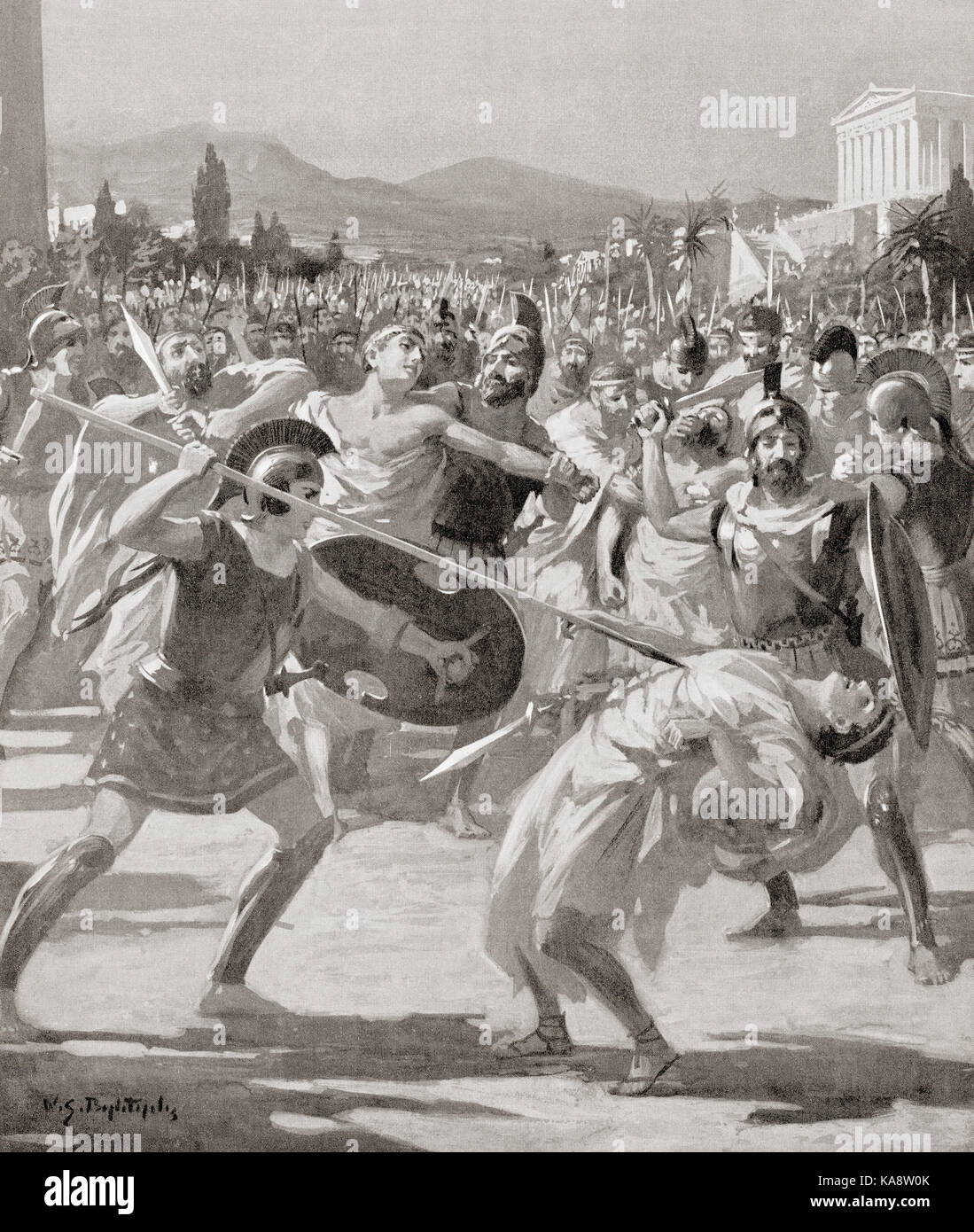 The assassination of Hipparchus or Hipparch by the tyrannicides, Harmodius and Aristogeiton in 514 BC. Hipparchus, died 514 BC, a member of the ruling class of Athens. He was one of the sons of Peisistratos and a tyrant of the city of Athens from 528/7 BC until his assassination. After the painting by W.S. Bagdatopoulus, (1888-1965). From Hutchinson's History of the Nations, published 1915. Stock Photohttps://www.alamy.com/image-license-details/?v=1https://www.alamy.com/stock-image-the-assassination-of-hipparchus-or-hipparch-by-the-tyrannicides-harmodius-161235107.html
The assassination of Hipparchus or Hipparch by the tyrannicides, Harmodius and Aristogeiton in 514 BC. Hipparchus, died 514 BC, a member of the ruling class of Athens. He was one of the sons of Peisistratos and a tyrant of the city of Athens from 528/7 BC until his assassination. After the painting by W.S. Bagdatopoulus, (1888-1965). From Hutchinson's History of the Nations, published 1915. Stock Photohttps://www.alamy.com/image-license-details/?v=1https://www.alamy.com/stock-image-the-assassination-of-hipparchus-or-hipparch-by-the-tyrannicides-harmodius-161235107.htmlRMKA8W0K–The assassination of Hipparchus or Hipparch by the tyrannicides, Harmodius and Aristogeiton in 514 BC. Hipparchus, died 514 BC, a member of the ruling class of Athens. He was one of the sons of Peisistratos and a tyrant of the city of Athens from 528/7 BC until his assassination. After the painting by W.S. Bagdatopoulus, (1888-1965). From Hutchinson's History of the Nations, published 1915.
 Terracotta kylix (drinking cup) mid-5th century B.C. Attributed to the Painter of Würzburg 487 Interior, Eros at a hermExterior, obverse and reverse, banquetersThe earliest herms were square stone pillars terminating in a bearded head of Hermes, the god of boundaries. They were introduced in Athens about 520 B.C by Hipparchos, the son of the tyrant Peisistratos, to mark points midway between the various Attic villages and the Athenian Agora. Soon herms stood before private houses and sanctuaries, as well.. Terracotta kylix (drinking cup) 254959 : Attributed to the Painter of W?rzburg 487, Ter Stock Photohttps://www.alamy.com/image-license-details/?v=1https://www.alamy.com/terracotta-kylix-drinking-cup-mid-5th-century-bc-attributed-to-the-painter-of-wrzburg-487-interior-eros-at-a-hermexterior-obverse-and-reverse-banquetersthe-earliest-herms-were-square-stone-pillars-terminating-in-a-bearded-head-of-hermes-the-god-of-boundaries-they-were-introduced-in-athens-about-520-bc-by-hipparchos-the-son-of-the-tyrant-peisistratos-to-mark-points-midway-between-the-various-attic-villages-and-the-athenian-agora-soon-herms-stood-before-private-houses-and-sanctuaries-as-well-terracotta-kylix-drinking-cup-254959-attributed-to-the-painter-of-wrzburg-487-ter-image458411672.html
Terracotta kylix (drinking cup) mid-5th century B.C. Attributed to the Painter of Würzburg 487 Interior, Eros at a hermExterior, obverse and reverse, banquetersThe earliest herms were square stone pillars terminating in a bearded head of Hermes, the god of boundaries. They were introduced in Athens about 520 B.C by Hipparchos, the son of the tyrant Peisistratos, to mark points midway between the various Attic villages and the Athenian Agora. Soon herms stood before private houses and sanctuaries, as well.. Terracotta kylix (drinking cup) 254959 : Attributed to the Painter of W?rzburg 487, Ter Stock Photohttps://www.alamy.com/image-license-details/?v=1https://www.alamy.com/terracotta-kylix-drinking-cup-mid-5th-century-bc-attributed-to-the-painter-of-wrzburg-487-interior-eros-at-a-hermexterior-obverse-and-reverse-banquetersthe-earliest-herms-were-square-stone-pillars-terminating-in-a-bearded-head-of-hermes-the-god-of-boundaries-they-were-introduced-in-athens-about-520-bc-by-hipparchos-the-son-of-the-tyrant-peisistratos-to-mark-points-midway-between-the-various-attic-villages-and-the-athenian-agora-soon-herms-stood-before-private-houses-and-sanctuaries-as-well-terracotta-kylix-drinking-cup-254959-attributed-to-the-painter-of-wrzburg-487-ter-image458411672.htmlRM2HHPCNC–Terracotta kylix (drinking cup) mid-5th century B.C. Attributed to the Painter of Würzburg 487 Interior, Eros at a hermExterior, obverse and reverse, banquetersThe earliest herms were square stone pillars terminating in a bearded head of Hermes, the god of boundaries. They were introduced in Athens about 520 B.C by Hipparchos, the son of the tyrant Peisistratos, to mark points midway between the various Attic villages and the Athenian Agora. Soon herms stood before private houses and sanctuaries, as well.. Terracotta kylix (drinking cup) 254959 : Attributed to the Painter of W?rzburg 487, Ter
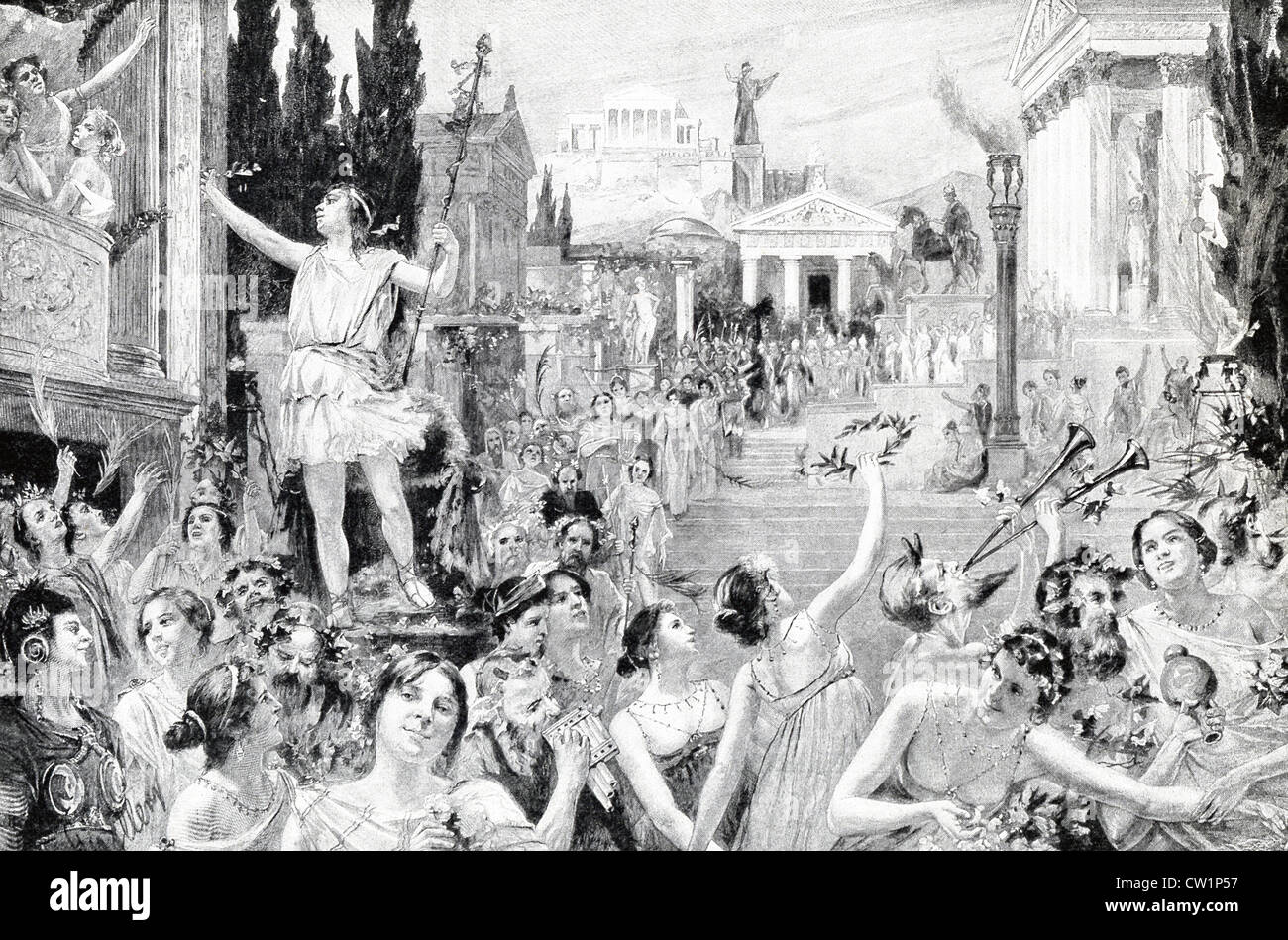 Peisistratus returns triumphantly from exile to Athens, Greece, and is welcomed by the people. Stock Photohttps://www.alamy.com/image-license-details/?v=1https://www.alamy.com/stock-photo-peisistratus-returns-triumphantly-from-exile-to-athens-greece-and-49826483.html
Peisistratus returns triumphantly from exile to Athens, Greece, and is welcomed by the people. Stock Photohttps://www.alamy.com/image-license-details/?v=1https://www.alamy.com/stock-photo-peisistratus-returns-triumphantly-from-exile-to-athens-greece-and-49826483.htmlRFCW1P57–Peisistratus returns triumphantly from exile to Athens, Greece, and is welcomed by the people.
 Marble head from a statue of Harmodios 1st–2nd century A.D. Original attributed to Kritios and Nesiotes Copy of a Greek bronze statue from the Tyrannicide group, erected in 477/476 B.C. and attributed to Kritios and NesiotesSoon after the advent of a democratic government in 510 B.C., Harmodios and Aristogeiton, the Athenian aristocrats who assassinated one of the sons of the tyrant Peisistratos, were commemorated with a pair of statues in the Agora at Athens. The Persians removed the statues during their sack of Athens in 480 B.C., and two new ones were erected in 477/476 B.C. For one hundred Stock Photohttps://www.alamy.com/image-license-details/?v=1https://www.alamy.com/marble-head-from-a-statue-of-harmodios-1st2nd-century-ad-original-attributed-to-kritios-and-nesiotes-copy-of-a-greek-bronze-statue-from-the-tyrannicide-group-erected-in-477476-bc-and-attributed-to-kritios-and-nesiotessoon-after-the-advent-of-a-democratic-government-in-510-bc-harmodios-and-aristogeiton-the-athenian-aristocrats-who-assassinated-one-of-the-sons-of-the-tyrant-peisistratos-were-commemorated-with-a-pair-of-statues-in-the-agora-at-athens-the-persians-removed-the-statues-during-their-sack-of-athens-in-480-bc-and-two-new-ones-were-erected-in-477476-bc-for-one-hundred-image458611470.html
Marble head from a statue of Harmodios 1st–2nd century A.D. Original attributed to Kritios and Nesiotes Copy of a Greek bronze statue from the Tyrannicide group, erected in 477/476 B.C. and attributed to Kritios and NesiotesSoon after the advent of a democratic government in 510 B.C., Harmodios and Aristogeiton, the Athenian aristocrats who assassinated one of the sons of the tyrant Peisistratos, were commemorated with a pair of statues in the Agora at Athens. The Persians removed the statues during their sack of Athens in 480 B.C., and two new ones were erected in 477/476 B.C. For one hundred Stock Photohttps://www.alamy.com/image-license-details/?v=1https://www.alamy.com/marble-head-from-a-statue-of-harmodios-1st2nd-century-ad-original-attributed-to-kritios-and-nesiotes-copy-of-a-greek-bronze-statue-from-the-tyrannicide-group-erected-in-477476-bc-and-attributed-to-kritios-and-nesiotessoon-after-the-advent-of-a-democratic-government-in-510-bc-harmodios-and-aristogeiton-the-athenian-aristocrats-who-assassinated-one-of-the-sons-of-the-tyrant-peisistratos-were-commemorated-with-a-pair-of-statues-in-the-agora-at-athens-the-persians-removed-the-statues-during-their-sack-of-athens-in-480-bc-and-two-new-ones-were-erected-in-477476-bc-for-one-hundred-image458611470.htmlRM2HJ3FH2–Marble head from a statue of Harmodios 1st–2nd century A.D. Original attributed to Kritios and Nesiotes Copy of a Greek bronze statue from the Tyrannicide group, erected in 477/476 B.C. and attributed to Kritios and NesiotesSoon after the advent of a democratic government in 510 B.C., Harmodios and Aristogeiton, the Athenian aristocrats who assassinated one of the sons of the tyrant Peisistratos, were commemorated with a pair of statues in the Agora at Athens. The Persians removed the statues during their sack of Athens in 480 B.C., and two new ones were erected in 477/476 B.C. For one hundred
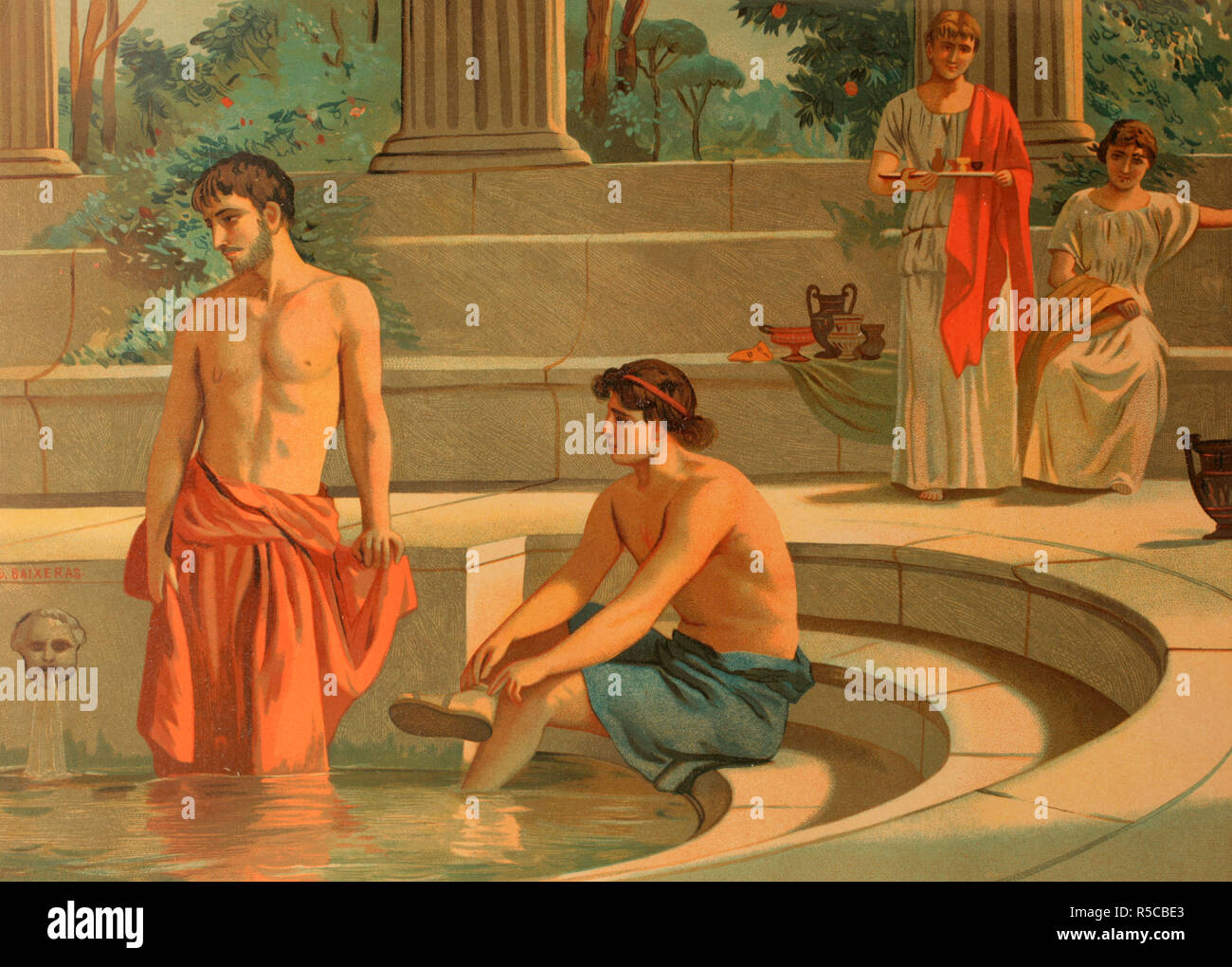 Peisistratos (youngest son of Nestor) and Telemachus (the son of Odysseus an Penelope), in the Palace of Menelaus in Sparta. Telemachus went to find his father and Nestor ordered Peisistratos to accompany him to the palace. Drawing by Dionisio Baixeras (1862-1943). Chromolithography. La Civilizacion (The Civilization), volume II, 1881. Stock Photohttps://www.alamy.com/image-license-details/?v=1https://www.alamy.com/peisistratos-youngest-son-of-nestor-and-telemachus-the-son-of-odysseus-an-penelope-in-the-palace-of-menelaus-in-sparta-telemachus-went-to-find-his-father-and-nestor-ordered-peisistratos-to-accompany-him-to-the-palace-drawing-by-dionisio-baixeras-1862-1943-chromolithography-la-civilizacion-the-civilization-volume-ii-1881-image227080507.html
Peisistratos (youngest son of Nestor) and Telemachus (the son of Odysseus an Penelope), in the Palace of Menelaus in Sparta. Telemachus went to find his father and Nestor ordered Peisistratos to accompany him to the palace. Drawing by Dionisio Baixeras (1862-1943). Chromolithography. La Civilizacion (The Civilization), volume II, 1881. Stock Photohttps://www.alamy.com/image-license-details/?v=1https://www.alamy.com/peisistratos-youngest-son-of-nestor-and-telemachus-the-son-of-odysseus-an-penelope-in-the-palace-of-menelaus-in-sparta-telemachus-went-to-find-his-father-and-nestor-ordered-peisistratos-to-accompany-him-to-the-palace-drawing-by-dionisio-baixeras-1862-1943-chromolithography-la-civilizacion-the-civilization-volume-ii-1881-image227080507.htmlRMR5CBE3–Peisistratos (youngest son of Nestor) and Telemachus (the son of Odysseus an Penelope), in the Palace of Menelaus in Sparta. Telemachus went to find his father and Nestor ordered Peisistratos to accompany him to the palace. Drawing by Dionisio Baixeras (1862-1943). Chromolithography. La Civilizacion (The Civilization), volume II, 1881.
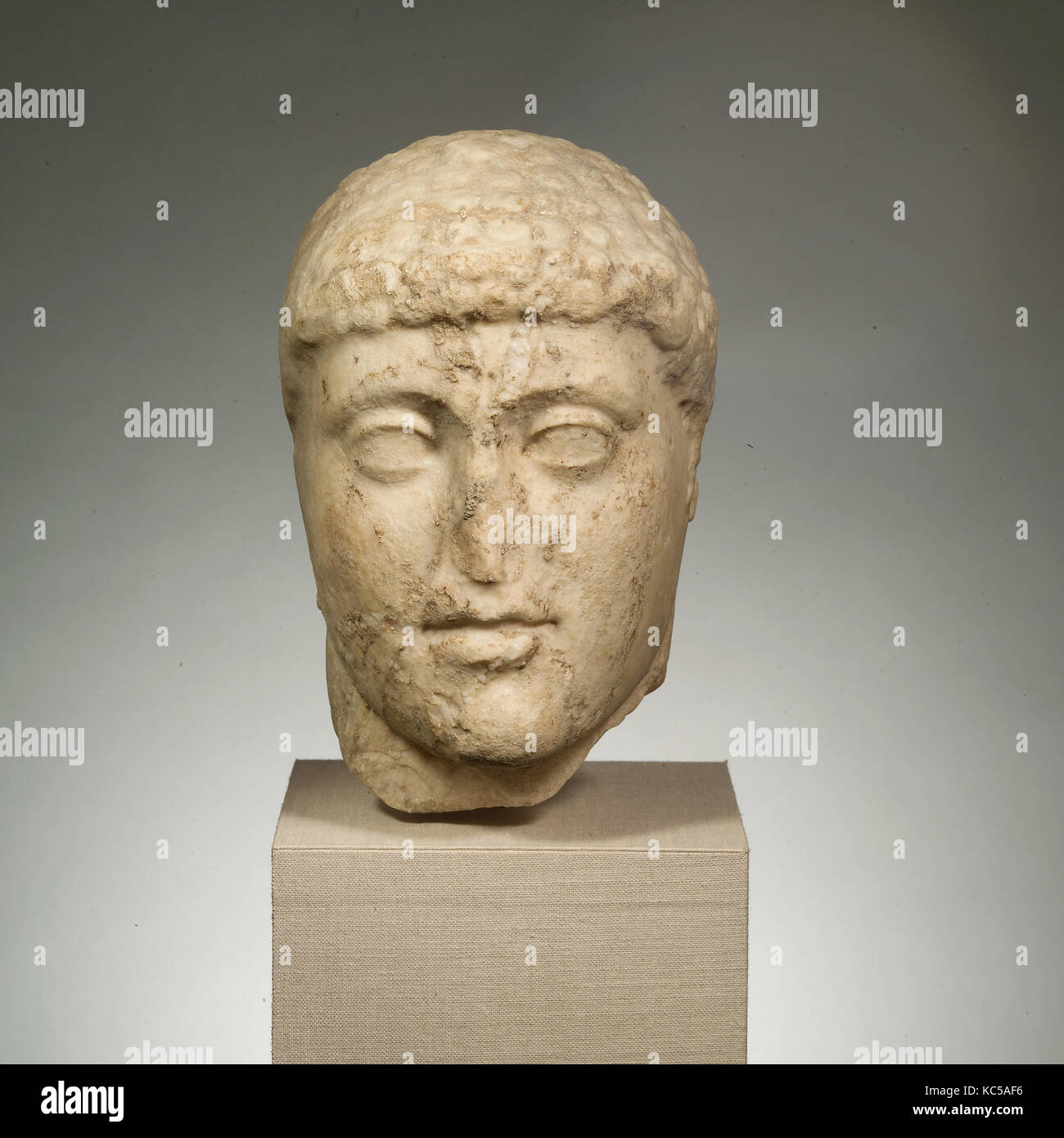 Marble head from a statue of Harmodios, 1st–2nd century A.D Stock Photohttps://www.alamy.com/image-license-details/?v=1https://www.alamy.com/stock-image-marble-head-from-a-statue-of-harmodios-1st2nd-century-ad-162387210.html
Marble head from a statue of Harmodios, 1st–2nd century A.D Stock Photohttps://www.alamy.com/image-license-details/?v=1https://www.alamy.com/stock-image-marble-head-from-a-statue-of-harmodios-1st2nd-century-ad-162387210.htmlRMKC5AF6–Marble head from a statue of Harmodios, 1st–2nd century A.D
 Art inspired by Marble head from a statue of Harmodios, Imperial, 1st–2nd century A.D., Roman, Marble, H. 10 in. (25.4 cm), Stone Sculpture, Copy of a Greek bronze statue from the Tyrannicide group, erected in 477/476 B.C. and attributed to Kritios and Nesiotes. Soon after the advent, Classic works modernized by Artotop with a splash of modernity. Shapes, color and value, eye-catching visual impact on art. Emotions through freedom of artworks in a contemporary way. A timeless message pursuing a wildly creative new direction. Artists turning to the digital medium and creating the Artotop NFT Stock Photohttps://www.alamy.com/image-license-details/?v=1https://www.alamy.com/art-inspired-by-marble-head-from-a-statue-of-harmodios-imperial-1st2nd-century-ad-roman-marble-h-10-in-254-cm-stone-sculpture-copy-of-a-greek-bronze-statue-from-the-tyrannicide-group-erected-in-477476-bc-and-attributed-to-kritios-and-nesiotes-soon-after-the-advent-classic-works-modernized-by-artotop-with-a-splash-of-modernity-shapes-color-and-value-eye-catching-visual-impact-on-art-emotions-through-freedom-of-artworks-in-a-contemporary-way-a-timeless-message-pursuing-a-wildly-creative-new-direction-artists-turning-to-the-digital-medium-and-creating-the-artotop-nft-image462932084.html
Art inspired by Marble head from a statue of Harmodios, Imperial, 1st–2nd century A.D., Roman, Marble, H. 10 in. (25.4 cm), Stone Sculpture, Copy of a Greek bronze statue from the Tyrannicide group, erected in 477/476 B.C. and attributed to Kritios and Nesiotes. Soon after the advent, Classic works modernized by Artotop with a splash of modernity. Shapes, color and value, eye-catching visual impact on art. Emotions through freedom of artworks in a contemporary way. A timeless message pursuing a wildly creative new direction. Artists turning to the digital medium and creating the Artotop NFT Stock Photohttps://www.alamy.com/image-license-details/?v=1https://www.alamy.com/art-inspired-by-marble-head-from-a-statue-of-harmodios-imperial-1st2nd-century-ad-roman-marble-h-10-in-254-cm-stone-sculpture-copy-of-a-greek-bronze-statue-from-the-tyrannicide-group-erected-in-477476-bc-and-attributed-to-kritios-and-nesiotes-soon-after-the-advent-classic-works-modernized-by-artotop-with-a-splash-of-modernity-shapes-color-and-value-eye-catching-visual-impact-on-art-emotions-through-freedom-of-artworks-in-a-contemporary-way-a-timeless-message-pursuing-a-wildly-creative-new-direction-artists-turning-to-the-digital-medium-and-creating-the-artotop-nft-image462932084.htmlRF2HW4AGM–Art inspired by Marble head from a statue of Harmodios, Imperial, 1st–2nd century A.D., Roman, Marble, H. 10 in. (25.4 cm), Stone Sculpture, Copy of a Greek bronze statue from the Tyrannicide group, erected in 477/476 B.C. and attributed to Kritios and Nesiotes. Soon after the advent, Classic works modernized by Artotop with a splash of modernity. Shapes, color and value, eye-catching visual impact on art. Emotions through freedom of artworks in a contemporary way. A timeless message pursuing a wildly creative new direction. Artists turning to the digital medium and creating the Artotop NFT
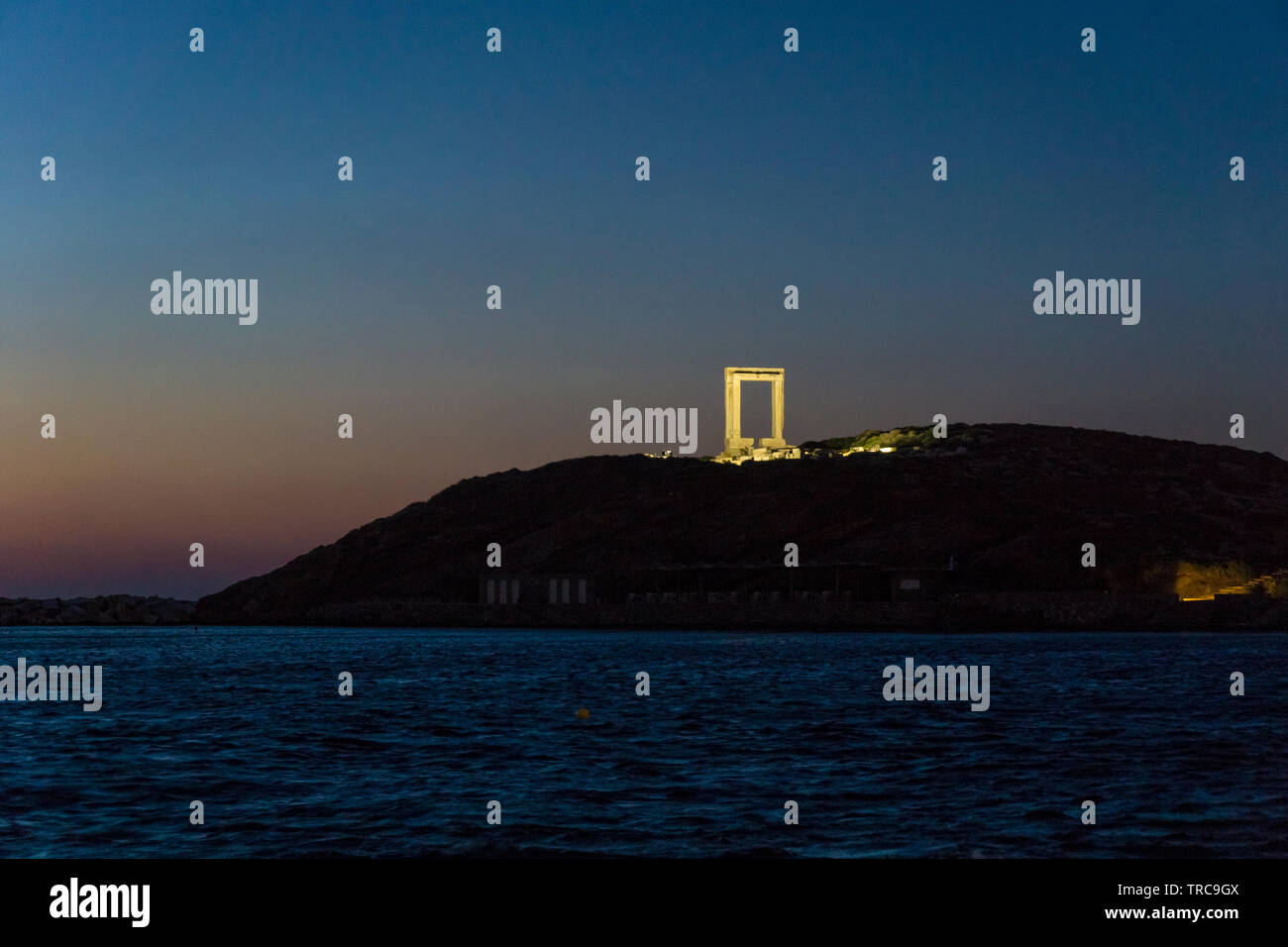 Lygdamis of Naxos Stock Photohttps://www.alamy.com/image-license-details/?v=1https://www.alamy.com/lygdamis-of-naxos-image255353194.html
Lygdamis of Naxos Stock Photohttps://www.alamy.com/image-license-details/?v=1https://www.alamy.com/lygdamis-of-naxos-image255353194.htmlRMTRC9GX–Lygdamis of Naxos
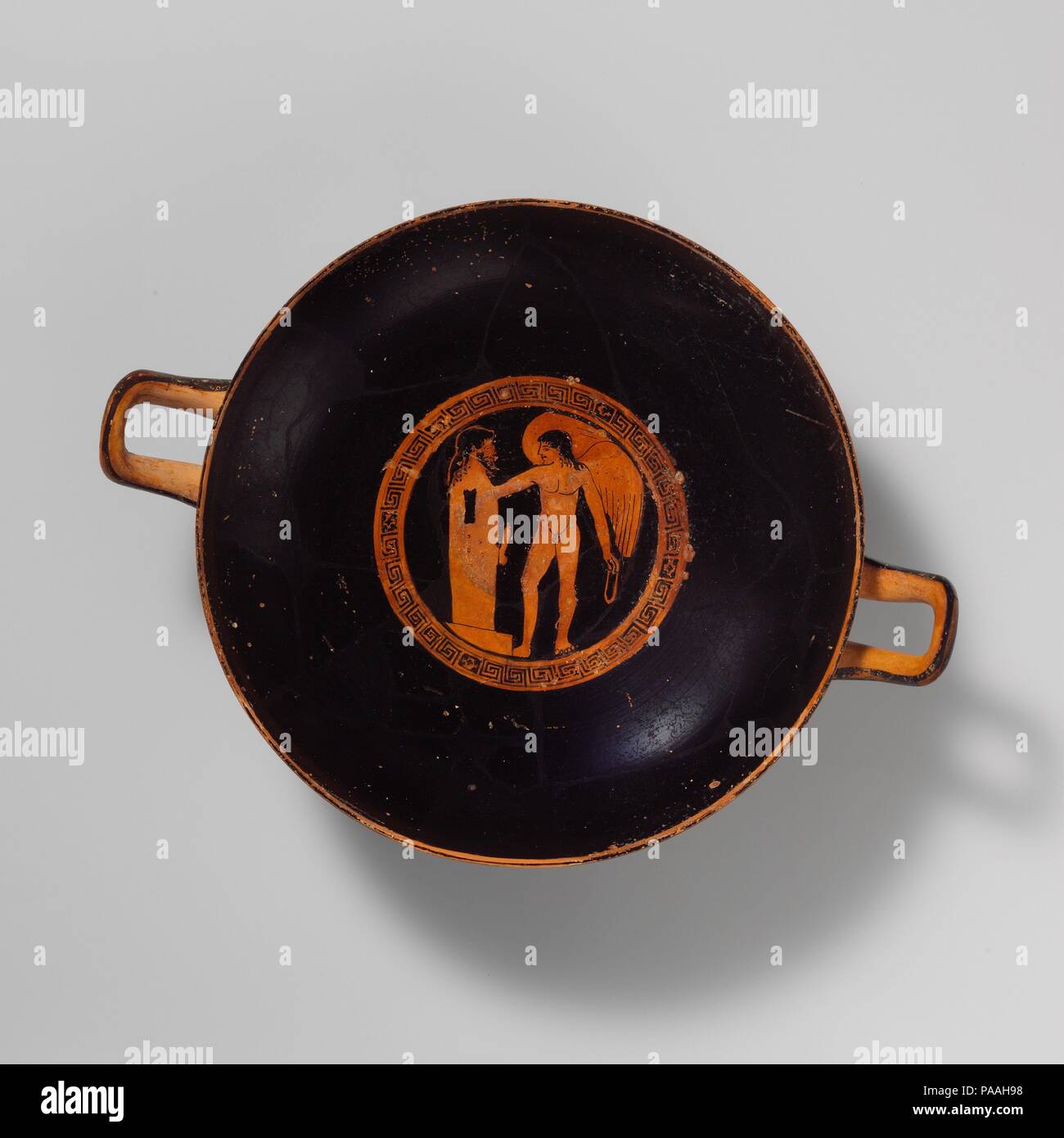 Terracotta kylix (drinking cup). Culture: Greek, Attic. Dimensions: width 11 3/4in. (29.9cm); diameter 9in. (22.9cm). Date: mid-5th century B.C.. Interior, Eros at a herm Exterior, obverse and reverse, banqueters The earliest herms were square stone pillars terminating in a bearded head of Hermes, the god of boundaries. They were introduced in Athens about 520 B.C by Hipparchos, the son of the tyrant Peisistratos, to mark points midway between the various Attic villages and the Athenian Agora. Soon herms stood before private houses and sanctuaries, as well. Museum: Metropolitan Museum of Stock Photohttps://www.alamy.com/image-license-details/?v=1https://www.alamy.com/terracotta-kylix-drinking-cup-culture-greek-attic-dimensions-width-11-34in-299cm-diameter-9in-229cm-date-mid-5th-century-bc-interior-eros-at-a-herm-exterior-obverse-and-reverse-banqueters-the-earliest-herms-were-square-stone-pillars-terminating-in-a-bearded-head-of-hermes-the-god-of-boundaries-they-were-introduced-in-athens-about-520-bc-by-hipparchos-the-son-of-the-tyrant-peisistratos-to-mark-points-midway-between-the-various-attic-villages-and-the-athenian-agora-soon-herms-stood-before-private-houses-and-sanctuaries-as-well-museum-metropolitan-museum-of-image212904084.html
Terracotta kylix (drinking cup). Culture: Greek, Attic. Dimensions: width 11 3/4in. (29.9cm); diameter 9in. (22.9cm). Date: mid-5th century B.C.. Interior, Eros at a herm Exterior, obverse and reverse, banqueters The earliest herms were square stone pillars terminating in a bearded head of Hermes, the god of boundaries. They were introduced in Athens about 520 B.C by Hipparchos, the son of the tyrant Peisistratos, to mark points midway between the various Attic villages and the Athenian Agora. Soon herms stood before private houses and sanctuaries, as well. Museum: Metropolitan Museum of Stock Photohttps://www.alamy.com/image-license-details/?v=1https://www.alamy.com/terracotta-kylix-drinking-cup-culture-greek-attic-dimensions-width-11-34in-299cm-diameter-9in-229cm-date-mid-5th-century-bc-interior-eros-at-a-herm-exterior-obverse-and-reverse-banqueters-the-earliest-herms-were-square-stone-pillars-terminating-in-a-bearded-head-of-hermes-the-god-of-boundaries-they-were-introduced-in-athens-about-520-bc-by-hipparchos-the-son-of-the-tyrant-peisistratos-to-mark-points-midway-between-the-various-attic-villages-and-the-athenian-agora-soon-herms-stood-before-private-houses-and-sanctuaries-as-well-museum-metropolitan-museum-of-image212904084.htmlRMPAAH98–Terracotta kylix (drinking cup). Culture: Greek, Attic. Dimensions: width 11 3/4in. (29.9cm); diameter 9in. (22.9cm). Date: mid-5th century B.C.. Interior, Eros at a herm Exterior, obverse and reverse, banqueters The earliest herms were square stone pillars terminating in a bearded head of Hermes, the god of boundaries. They were introduced in Athens about 520 B.C by Hipparchos, the son of the tyrant Peisistratos, to mark points midway between the various Attic villages and the Athenian Agora. Soon herms stood before private houses and sanctuaries, as well. Museum: Metropolitan Museum of
 Peisistratus wishing to gain power in Athens secretly wounded himself, and, appearing in public covered in blood, accused his enemies of attacking him. By this method he managed to get a bodyguard which he privately increased until he was in a position to make himself tyrant of Athens in 560 BC. Peisistratos, aka Pisistratus. Son of Hippocrates, and a ruler of ancient Athens. After the painting by Ambrose Dudley, (1867-1951). From Hutchinson's History of the Nations, published 1915. Stock Photohttps://www.alamy.com/image-license-details/?v=1https://www.alamy.com/stock-image-peisistratus-wishing-to-gain-power-in-athens-secretly-wounded-himself-161234853.html
Peisistratus wishing to gain power in Athens secretly wounded himself, and, appearing in public covered in blood, accused his enemies of attacking him. By this method he managed to get a bodyguard which he privately increased until he was in a position to make himself tyrant of Athens in 560 BC. Peisistratos, aka Pisistratus. Son of Hippocrates, and a ruler of ancient Athens. After the painting by Ambrose Dudley, (1867-1951). From Hutchinson's History of the Nations, published 1915. Stock Photohttps://www.alamy.com/image-license-details/?v=1https://www.alamy.com/stock-image-peisistratus-wishing-to-gain-power-in-athens-secretly-wounded-himself-161234853.htmlRMKA8TKH–Peisistratus wishing to gain power in Athens secretly wounded himself, and, appearing in public covered in blood, accused his enemies of attacking him. By this method he managed to get a bodyguard which he privately increased until he was in a position to make himself tyrant of Athens in 560 BC. Peisistratos, aka Pisistratus. Son of Hippocrates, and a ruler of ancient Athens. After the painting by Ambrose Dudley, (1867-1951). From Hutchinson's History of the Nations, published 1915.
 Peisistratos (youngest son of Nestor) and Telemachus (the son of Odysseus an Penelope), in the Palace of Menelaus in Sparta. Telemachus went to find his father and Nestor ordered Peisistratos to accompany him to the palace. Drawing by Dionisio Baixeras (1862-1943). Chromolithography. La Civilizacion (The Civilization), volume II, 1881. Stock Photohttps://www.alamy.com/image-license-details/?v=1https://www.alamy.com/peisistratos-youngest-son-of-nestor-and-telemachus-the-son-of-odysseus-an-penelope-in-the-palace-of-menelaus-in-sparta-telemachus-went-to-find-his-father-and-nestor-ordered-peisistratos-to-accompany-him-to-the-palace-drawing-by-dionisio-baixeras-1862-1943-chromolithography-la-civilizacion-the-civilization-volume-ii-1881-image227912663.html
Peisistratos (youngest son of Nestor) and Telemachus (the son of Odysseus an Penelope), in the Palace of Menelaus in Sparta. Telemachus went to find his father and Nestor ordered Peisistratos to accompany him to the palace. Drawing by Dionisio Baixeras (1862-1943). Chromolithography. La Civilizacion (The Civilization), volume II, 1881. Stock Photohttps://www.alamy.com/image-license-details/?v=1https://www.alamy.com/peisistratos-youngest-son-of-nestor-and-telemachus-the-son-of-odysseus-an-penelope-in-the-palace-of-menelaus-in-sparta-telemachus-went-to-find-his-father-and-nestor-ordered-peisistratos-to-accompany-him-to-the-palace-drawing-by-dionisio-baixeras-1862-1943-chromolithography-la-civilizacion-the-civilization-volume-ii-1881-image227912663.htmlRMR6P8WY–Peisistratos (youngest son of Nestor) and Telemachus (the son of Odysseus an Penelope), in the Palace of Menelaus in Sparta. Telemachus went to find his father and Nestor ordered Peisistratos to accompany him to the palace. Drawing by Dionisio Baixeras (1862-1943). Chromolithography. La Civilizacion (The Civilization), volume II, 1881.